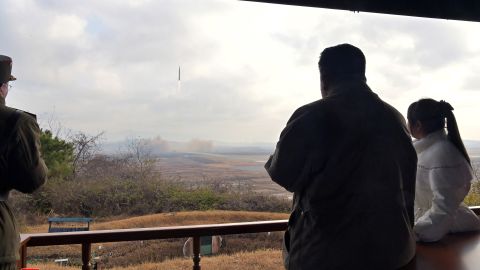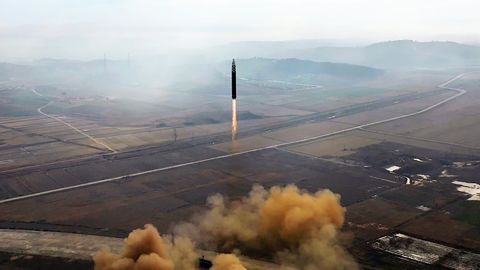Seoul, South Korea
CNN
—
Father and daughter walking hand in hand near a towering weapon of mass destruction.
That was the scene North Korea showed the world on Saturday as state media released the first pictures of Kim Jong Un with a child believed to be his daughter, Ju Ae, inspecting what experts say is an intercontinental ballistic missile (ICBM).
North Korea said the missile launched Friday from Pyongyang International Airfield was a Hwasong-17, a huge rocket that could theoretically deliver a nuclear warhead to the mainland United States.
But even after Kim warned that his nuclear forces are prepared to engage in “actual war” with Washington and its allies South Korea and Japan, it was the girl, not the missile, who grabbed the world’s attention.
What did her presence at the launch mean? Could she be a possible successor to Kim? What does an approximately 9-year-old girl have to do with nuclear arms?
Leif-Eric Easley, associate professor of international studies at Ewha Womans University in Seoul, said the girl’s presence should be seen through a domestic lens.
“Outside North Korea, it may appear deranged to pose for the cameras hand in hand with a child in front of a long-range missile designed to deliver a nuclear weapon to a distant city,” Easley said.
“But inside North Korea, a purportedly successful launch of the world’s largest road-mobile ICBM is cause for national celebration.”
Yang Moo-jin, president of the University of North Korean Studies in the South, also noted the domestic tilt in the images of Kim’s daughter.
“By showing some quality time with his daughter, it looked like he (Kim) wanted to show his family as a good and stable one, and to show himself as a leader for normal people,” Yang told Canadian broadcaster Global News.
The images also presented the girl as a key member of the Kim bloodline, Yang said.

North Korea has been ruled as a hereditary dictatorship since its founding in 1948 by Kim Il Sung. His son, Kim Jong Il, took over after his father’s death in 1994. And Kim Jong Un took power 17 years later when Kim Jong Il died.
But any near-term change in the North Korean leadership is highly unlikely.
Kim Jong Un is only 38 years old. And even if some unexpected problem were to take his life, Ju Ae is likely at least a decade or more away from being able to replace her father atop the North Korean state.
“I’m genuinely unsure about the succession implications of his daughter being introduced,” said Ankit Panda, senior fellow in the nuclear policy program at the Carnegie Endowment for International Peace.
“On the one hand, publicly revealing (a) child can’t be taken lightly by any North Korean leader, but she’s underage and her role at the test wasn’t particularly punched up by state media,” he said.
Panda noted that video released by North Korea of Friday’s ICBM launch may prove much more valuable to Western intelligence than anything gleaned from Kim’s daughter’s presence.
“The US has sophisticated sources and methods that’ll give it tremendous insight into North Korea’s missiles, but the video may be helpful for building a more complete model of the missile’s performance,” he said.
“In the past, analysts have used videos to derive the acceleration of the missile at launch, which can help us identify its overall performance.”

It was only the third time Pyongyang has released a video of a missile launch since 2017, according to Panda.
“The North Koreans used to be considerably more transparent prior to 2017, when their primary concern was the credibility of their nuclear deterrent,” he said.
While Friday’s test did show Pyongyang can launch a large ICBM and keep it aloft for more than an hour, North Korea still hasn’t demonstrated the ability to place a warhead atop a long-range ballistic missile – projectiles that are fired into space – that’s able to survive the fiery reentry into Earth’s atmosphere before plunging to their target.
But analysts say with their repeated tests, the North Koreans are refining their processes. A missile believed to be a Hwasong-17 ICBM tested earlier this month failed in the early stages of its flight.
“The fact that (Friday’s test) didn’t blow up indicates they have made progress in fixing the technical issues that marked previous tests,” said Hans Kristensen, director of the Nuclear Information Project at the Federation of American Scientists.
What comes next from North Korea is anybody’s guess.
For much of this year, Western analysts and intelligence sources have been predicting North Korea will test a nuclear weapon, with satellite imagery showing activity at the nuclear test site. Such a test would be Pyongyang’s first in five years.
But Yang, the University of North Korean Studies president, told Global News that Friday’s test may have dampened any urgency for a nuclear test, at least for the time being.
“The possibility of North Korea’s seventh nuclear test to be conducted in November seems a little low now,” he said.
But another ICBM test could be Pyongyang’s response if the US continues to bolster its military presence in the region and expands exercises with South Korea and Japan, he said.